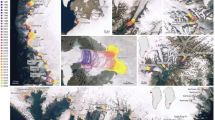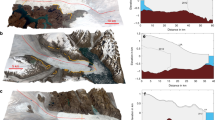Abstract
Glaciers and ice caps peripheral to the main Greenland Ice Sheet contribute markedly to sea-level rise1,2,3. Their changes and variability, however, have been difficult to quantify on multi-decadal timescales due to an absence of long-term data4. Here, using historical aerial surveys, expedition photographs, spy satellite imagery and new remote-sensing products, we map glacier length fluctuations of approximately 350 peripheral glaciers and ice caps in East and West Greenland since 1890. Peripheral glaciers are found to have recently undergone a widespread and significant retreat at rates of 12.2 m per year and 16.6 m per year in East and West Greenland, respectively; these changes are exceeded in severity only by the early twentieth century post-Little-Ice-Age retreat. Regional changes in ice volume, as reflected by glacier length, are further shown to be related to changes in precipitation associated with the North Atlantic Oscillation (NAO), with a distinct east–west asymmetry; positive phases of the NAO increase accumulation, and thereby glacier growth, in the eastern periphery, whereas opposite effects are observed in the western periphery. Thus, with projected trends towards positive NAO in the future5,6, eastern peripheral glaciers may remain relatively stable, while western peripheral glaciers will continue to diminish.
This is a preview of subscription content, access via your institution
Access options
Access Nature and 54 other Nature Portfolio journals
Get Nature+, our best-value online-access subscription
$29.99 / 30 days
cancel any time
Subscribe to this journal
Receive 12 print issues and online access
$209.00 per year
only $17.42 per issue
Buy this article
- Purchase on Springer Link
- Instant access to full article PDF
Prices may be subject to local taxes which are calculated during checkout



Similar content being viewed by others
References
Bolch, T. et al. Mass loss of Greenland’s glaciers and ice caps 2003–2008 revealed from ICESat laser altimetry data. Geophys. Res. Lett. 40, 875–881 (2013).
Colgan, W. et al. Hybrid glacier inventory, gravimetry and altimetry (HIGA) mass balance product for Greenland and the Canadian Arctic. Remote Sens. Environ. 168, 24–39 (2015).
Gardner, A. et al. A reconciled estimate of glacier contributions to sea level rise: 2003 to 2009. Science 340, 852–857 (2013).
Bjørk, A. A. et al. An aerial view of 80 years of climate-related glacier fluctuations in southeast Greenland. Nat. Geosci. 5, 427–432 (2012).
IPCC Climate Change 2013: The Physical Science Basis (eds Stocker, T. F. et al.) (Cambridge Univ. Press, Cambridge, 2013).
Gillett, N. P. & Fyfe, J. C. Annular mode changes in the CMIP5 simulations. Geophys. Res. Lett. 40, 1189–1193 (2013).
Machguth, H. et al. The future sea-level rise contribution of Greenland’s glaciers and ice caps. Environ. Res. Lett. 8, 025005 (2013).
Bintanja, R. & Selten, F. M. Future increases in Arctic precipitation linked to local evaporation and sea-ice retreat. Nature 509, 479–482 (2014).
Khan, S. A. et al. Sustained mass loss of the northeast Greenland ice sheet triggered by regional warming. Nat. Clim. Change 4, 292–299 (2014).
Csatho, B. M. et al. Laser altimetry reveals complex pattern of Greenland Ice Sheet dynamics. Proc. Natl Acad. Sci. USA 111, 18478–18483 (2014).
Leclercq, P. W. et al. Brief communication “Historical glacier length changes in West Greenland”. Cryosphere 6, 1339–1343 (2012).
Kjeldsen, K. K. et al. Spatial and temporal distribution of mass loss from the Greenland Ice Sheet since ad 1900. Nature 528, 396–400 (2015).
Bahr, D. B., Pfeifer, W. T., Sassolas, C. & Meier, M. F. Response time of glaciers as a function of size and mass balance: 1. Theory. J. Geophys. Res. 103, 9777–9782 (1998).
Leclercq, P. W. et al. A data set of worldwide glacier length fluctuations. Cryosphere 8, 659–672 (2014).
Box, J. E. Greenland ice sheet mass balance reconstruction. Part II: Surface mass balance (1840–2010). J. Clim. 26, 6974–6989 (2013).
Hurrell, J. W. Decadal trends in the North Atlantic Oscillation: regional temperatures and precipitation. Science 269, 676–679 (1995).
Johannesson, T., Raymond, C. & Waddington, E. Time-scale for adjustment of glaciers to changes in mass balance. J. Glaciol. 35, 355–369 (1989).
Hebbeln, D., Dokken, T., Andersen, E. S., Hald, M. & Elverhøi, A. Moisture supply for northern ice-sheet growth during the Last Glacial Maximum. Nature 370, 357–360 (1994).
Schmith, T. & Hansen, C. Fram Strait ice export during the nineteenth and twentieth centuries reconstructed from a multiyear sea ice index from southwestern Greenland. J. Clim. 16, 2782–2791 (2003).
Hanna, E. et al. Greenland Ice Sheet surface mass balance 1870 to 2010 based on twentieth century reanalysis, and links with global climate forcing. J. Geophys. Res. 116, D24121 (2011).
Hanna, E., Cropper, T. E., Hall, R. J. & Cappelen, J. Greenland blocking index 1851–2015: a regional climate change signal. Int. J. Climatol. 36, 4847–4861 (2016).
Auger, J. D., Birkel, S. D., Maasch, K. A., Mayewski, P. A. & Schuenemann, K. C. Examination of precipitation variability in southern Greenland. J. Geophys. Res. Atmos. 122, 6202–6216 (2017).
Appenzeller, C., Schwander, J., Sommer, S. & Stocker, T. F. The North Atlantic Oscillation and its imprint on precipitation and ice accumulation in Greenland. Geophys. Res. Lett. 25, 1939–1942 (1998).
Burgess, E. W. et al. A spatially calibrated model of annual accumulation rate on the Greenland Ice Sheet (1958–2007). J. Geophys. Res. 115, F02004 (2010).
Marzeion, B., Jarosch, A. H. & Hofer, M. Past and future sea-level change from the surface mass balance of glaciers. Cryosphere 6, 1295–1322 (2012).
Radić, V. et al. Regional and global projections of twenty-first century glacier mass changes in response to climate scenarios from global climate models. Clim. Dyn. 42, 37–58 (2014).
van den Broeke, M. et al. Partitioning recent Greenland mass loss. Science 326, 984–986 (2009).
Rignot, E., Box, J. E., Burgess, E. & Hanna, E. Mass balance of the Greenland ice sheet from 1958 to 2007. Geophys. Res. Lett. 35, L20502 (2008).
Kalnay, E. et al. The NCEP/NCAR 40-year reanalysis project. Bull. Am. Meteorol. Soc. 77, 437–471 (1996).
Cappelen, J. Greenland—DMI Historical Climate Data Collection 1784-2016 DMI Report 17-04 (Danish Meteorological Institute, 2017).
Korsgaard, N. J. et al. Digital elevation model and orthophotographs of Greenland based on aerial photographs from 1978–1987. Sci. Data 3, 160032 (2016).
van Angelen, J. H., van den Broeke, M. R. & van de Berg, W. J. Momentum budget of the atmospheric boundary layer over the Greenland ice sheet and its surrounding seas. J. Geophys. Res. 116, D10101 (2011).
Acknowledgements
A.A.B. was supported by the Independent Research Fund Denmark (grant DFF-610800469) and VILLUM Foundation (grant 10100), and by the Inge Lehmann Scholarship from the Royal Danish Academy of Science and Letters. K.K.K was supported by Independent Research Fund Denmark (grant DFF-4090-00151).C.S.A. and N.K.L. acknowledge support from the VILLUM Foundation (grant no. 10100 and grant no. VRK023440). We are also grateful for the support from the former National Danish Survey and Cadastre, now Department of Data-supply and Efficiency, and the Norwegian Polar Institute without whose help this study could not have been realized.
Author information
Authors and Affiliations
Contributions
A.A.B. and K.H.K. designed the study. S.A., A.L. and A.A.B. performed the analysis of aerial photographs and satellite imagery. J.E.B., W.T.C. and K.K.K. created and analysed accumulation and temperature records. S.A.K., C.S.A., N.K.L., N.J.K., H.M., J.C. and Y.P. supplied the data for analysis in the discussion. All authors contributed to the discussion of the results and the writing of the manuscript.
Corresponding author
Ethics declarations
Competing interests
The authors declare no competing financial interests.
Additional information
Publisher’s note: Springer Nature remains neutral with regard to jurisdictional claims in published maps and institutional affiliations.
Supplementary information
Supplementary Information
Supplementary Tables 1–5, Supplementary Figures 1–15 and Supplementary References
Rights and permissions
About this article
Cite this article
Bjørk, A.A., Aagaard, S., Lütt, A. et al. Changes in Greenland’s peripheral glaciers linked to the North Atlantic Oscillation. Nature Clim Change 8, 48–52 (2018). https://doi.org/10.1038/s41558-017-0029-1
Received:
Accepted:
Published:
Issue Date:
DOI: https://doi.org/10.1038/s41558-017-0029-1
This article is cited by
-
Greenland-wide accelerated retreat of peripheral glaciers in the twenty-first century
Nature Climate Change (2023)
-
Learning from Alfred Wegener’s pioneering field observations in West Greenland after a century of climate change
Scientific Reports (2023)
-
Greenland ice sheet climate disequilibrium and committed sea-level rise
Nature Climate Change (2022)
-
Abrupt Common Era hydroclimate shifts drive west Greenland ice cap change
Nature Geoscience (2021)



